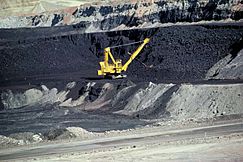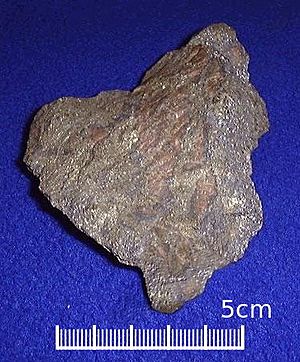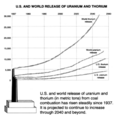Non-renewable resource facts for kids
A non-renewable resource is a natural resource that is used up faster than it can be made by nature. It cannot be produced, grown or generated on a scale which can sustain how quickly it is being consumed. Once it is used up, there is no more available for the future. Fossil fuels (such as coal, petroleum, and natural gas), types of nuclear power (uranium) are examples. Gold, silver, and iron are considered to be nonrenewable resources. Resources such as timber (when harvested sustainably) can be called a renewable resources. Non-renewable resources are also called exhaustible resources.
Contents
Earth minerals and metal ores
Earth minerals and metal ores are examples of non-renewable resources. The metals themselves are present in vast amounts in Earth's crust, and their extraction by humans only occurs where they are concentrated by natural geological processes (such as heat, pressure, organic activity, weathering and other processes) enough to become economically viable to extract. These processes generally take from tens of thousands to millions of years, through plate tectonics, tectonic subsidence and crustal recycling.
The localized deposits of metal ores near the surface which can be extracted economically by humans are non-renewable in human time-frames. There are certain rare earth minerals and elements that are more scarce and exhaustible than others. These are in high demand in manufacturing, particularly for the electronics industry.
Fossil fuels
Natural resources such as coal, petroleum (crude oil) and natural gas take thousands of years to form naturally and cannot be replaced as fast as they are being consumed. Eventually it is considered that fossil-based resources will become too costly to harvest and humanity will need to shift its reliance to other sources of energy such as solar or wind power, see renewable energy.
The modern-day fossil fuel economy is widely criticized for its lack of renewability, as well as being a contributor to climate change.
Nuclear fuels
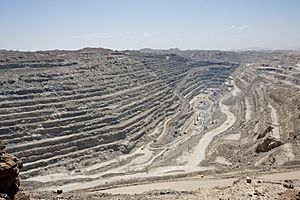
In 1987, the World Commission on Environment and Development (WCED) classified fission reactors that produce more fissile nuclear fuel than they consume (i.e. breeder reactors) among conventional renewable energy sources, such as solar and falling water. The American Petroleum Institute likewise does not consider conventional nuclear fission as renewable, but rather that breeder reactor nuclear power fuel is considered renewable and sustainable, noting that radioactive waste from used spent fuel rods remains radioactive and so has to be very carefully stored for several hundred years. With the careful monitoring of radioactive waste products also being required upon the use of other renewable energy sources, such as geothermal energy.
Land surface
Land surface can be considered both renewable and non-renewable resource. Land can be reused but new land cannot be created.
Renewable resources
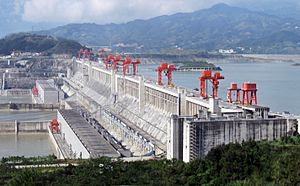
Natural resources, known as renewable resources, are replaced by natural processes and forces persistent in the natural environment.
The production of goods and services by manufacturing products in economic systems creates many types of waste during production and after the consumer has made use of it. The material is then either incinerated, buried in a landfill or recycled for reuse.
Recycling turns materials of value that would otherwise become waste into valuable resources again.
In the natural environment water, forests, plants and animals are all renewable resources, as long as they are adequately monitored, protected and conserved. Sustainable agriculture is the cultivation of plant and animal materials in a manner that preserves plant and animal ecosystems and that can improve soil health and soil fertility over the long term. The overfishing of the oceans is one example of where an industry practice or method can threaten an ecosystem, endanger species and possibly even determine whether or not a fishery is sustainable for use by humans. An unregulated industry practice or method can lead to a complete resource depletion.
The renewable energy from the sun, wind, wave, biomass and geothermal energies are based on renewable resources. Renewable resources such as the movement of water (hydropower, tidal power and wave power), wind and radiant energy from geothermal heat (used for geothermal power) and solar energy (used for solar power) are practically infinite and cannot be depleted, unlike their non-renewable counterparts, which are likely to run out if not used sparingly.
Images for kids
-
Annual release of "technologically enhanced"/concentrated Naturally occurring radioactive material, uranium and thorium radioisotopes naturally found in coal and concentrated in heavy/bottom coal ash and airborne fly ash. As predicted by ORNL to cumulatively amount to 2.9 million tons over the 1937–2040 period, from the combustion of an estimated 637 billion tons of coal worldwide. This 2.9 million tons of actinide fuel, a resource derived from coal ash, would be classified as low grade uranium ore if it occurred naturally.
-
Satellite map showing areas flooded by the Three Gorges reservoir. Compare 7 November 2006 (above) with 17 April 1987 (below). The energy station required the flooding of archaeological and cultural sites and displaced some 1.3 million people, and is causing significant ecological changes, including an increased risk of landslides. The dam has been a controversial topic both domestically and abroad.
See also
 In Spanish: Recurso no renovable para niños
In Spanish: Recurso no renovable para niños


